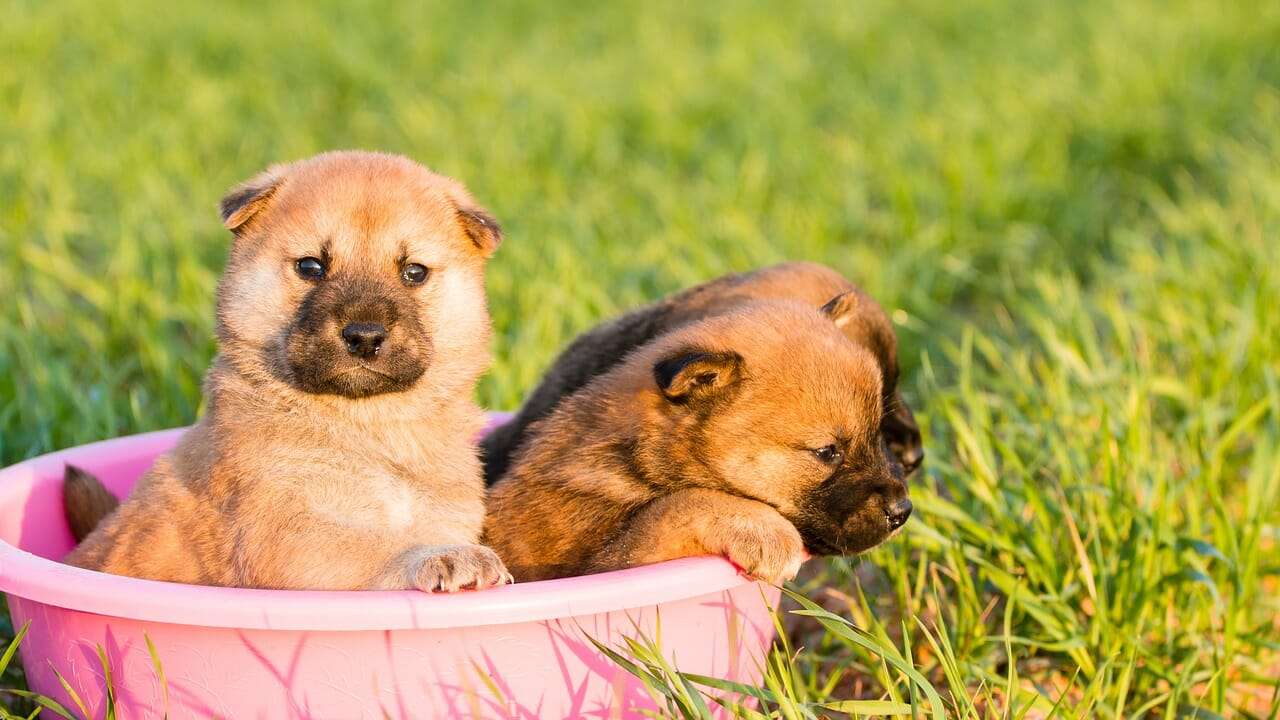Is it your first time taking care of a litter of puppies? Raising puppies is a great responsibility and it comes with many challenges that will stand in your way. One of those challenges is going to be teaching puppies to transition from mother’s milk to solid food. Many first-time dog breeders often ask the same question: How long do puppies need milk?
If you’ve never taken care of these adorable fluffy creatures, we’re going to help you through the process. It is important to learn how to guide a puppy through this process of transition. Puppies grow up quickly but the first few weeks of their life can greatly influence their health and well-being in the future. Here’s everything you need to know about puppies, milk, and the transition to solid food!

How Long Do Puppies Drink Milk From Their Mother
The process during which a puppy transition from mother’s milk to solid food is called weaning. However, before they get to the weaning stage, puppies go through the nursing process, which is very important for their health. Mother’s milk provides all the necessary nutrients and vitamins that puppies need in order to grow.
The natural dog’s milk also contains the antibodies the puppies need to fight off disease and health issues. Therefore, it is important for a puppy to consume the mother’s milk for the first few weeks of its life. In fact, mother’s milk is the only food they can eat in the first three to four weeks after being born.
The nursing process naturally ends around the fourth week of the puppy’s life. That’s when the puppy’s teeth start coming in, which makes the nursing process uncomfortable for the puppy’s mother. The mother then starts distancing herself from the puppies, allowing them to seek food elsewhere.
That’s when you should step in and offer the puppy some natural milk alternatives to solid food. Therefore, to answer your question, puppies need mother’s milk for the first four weeks of their lives, after which the weaning process begins.
How To Help Puppies Transition From Milk to Solid Food
The weaning process is often natural but it is important for dog owners to learn how to help their puppies go through it. The transition from mother’s milk to solid food should be made slowly in order for the puppy to get used to the new food. One way to help the puppy make this change is to offer it weaning replacement. Stick around to the end of the article where we will introduce the five most popular puppy milk alternatives.
Once you notice that the puppy’s mother is distancing herself from the puppy and not allowing it to drink more milk, it’s time to jump in and help. Serve the puppy small portions of solid food mixed with the best puppy milk replacer. This combination of wet and dry dog food will help the puppy get used to it more quickly.
Make sure to only use the food that is actually formulated for puppies, not adult dogs. As your puppy starts getting used to the wet and dry dog food combination, you can slowly start reducing the amount of liquid and increasing the amount of dry food. Do this until the puppy starts eating solid food consistently without any liquid at all.
Make sure to serve the puppy small portions of food four times throughout the day. It is important that the dog always has fresh water available, regardless of when they’re being fed. Lastly, serve the puppy’s first food in very shallow bowls. This way they will be able to get used to eating from a bowl, which might seem intimidating to them at first!
What To Expect During the Weaning Process
The process of transitioning from mother’s milk to solid food is often natural but there are difficulties that you might come across. Puppies are naturally curious and it’s normal for them to get excited when facing something they’ve never seen before. That’s why you can expect them to act too excited when they see the food, which can get messy.
Some puppies even walk right into the bowl while eating. Be prepared to clean up the puppies right after they eat. You can easily clean them up using paper towels moist in warm water. However, make sure to dry the puppies off after cleaning them so they don’t get cold and sick.
On the other hand, while some puppies get too excited to eat dog food, they are going to be scared and hesitant. If your puppy doesn’t show any interest in the food served in the bowl, try feeding them right from your hand and then slowly moving the bowl toward them. If they still refuse the food, try with different products and puppy milk alternatives, which we will review below!
What To Do If the Mother Is Not Cooperating
It is common for dog mothers to be sort of reluctant when it comes to puppy feeding habits. Even though most puppy mothers naturally distance themselves when it is time (around the fourth week of the pup’s birth) some dogs simply don’t want to stay away from their puppies.
In case this happens to you, you will have to separate the mother from the puppies a few times a day and feed the puppies the same way we explained above. Keep in mind that the dog mother won’t like the idea of being separated from her children. That’s why you have to engage her in a fun activity or a game so she doesn’t get too anxious.
After all, you are only helping the puppies to transition to solid food during the right time of their development process. Separating the puppies from their mother for at least two hours a day after four weeks of life will help them become independent faster. Make sure to give the mother a toy or some treats to keep her occupied while you tend to her babies.
The End of the Weaning Process
The weaning process usually ends around eighth to twelfth week of the puppy’s life. That’s when the puppy should be used to eating solid food for young dogs. The length of the weaning process depends on your puppy so we cannot exactly set a date when they will be done with the transition process.
However, after 12 weeks of life, the puppy should be eating solid food for four times a day without any issues. If that’s not the case, there might be a reason why they cannot transition in time. We would recommend visiting a veterinarian if you notice that your puppy is not developing in the right place.
After the puppy is used to eating solid food, you can consider giving them up for adoption if that’s what you planned on doing. In most states, eight weeks is the minimum age of a puppy for adoption. Therefore, don’t think about giving them up before they are completely independent and separated from their mother. Otherwise, early separation can cause physical and mental issues that will hinder the dog’s development.
Can Puppies Drink the Milk Humans Drink?
Another question we often get is whether puppies can drink the same milk we do. The short answer is absolutely not. According to the Banfield Pet Hospital, dog owners should avoid feeding their puppies cow’s milk because of potential health risks. Namely, the milk we drink can dehydrate dogs and leave negative consequences.

Puppies cannot process cow’s milk properly, which can cause diarrhea. However, if you are looking for other alternative milk products to offer the puppy as a replacement for mother’s milk, there are plenty of products manufactured for this purpose! The market offers plenty of products that can provide adequate nutrition without upsetting the puppy’s digestive system! Below are the best puppy milk replacer options available!
Top Five Milk Alternatives for Puppies
It is important that the puppy receives the right combination of nutrients while transitioning from mother’s milk to solid food. That is why it is recommended to use milk replacers as a source of vitamins and minerals needed for healthy development. High-quality milk replacement formulas often include ingredients such as skimmed milk, protein isolates, vegetable oil, and egg products.
There are two types of formulas available on the market: liquid and powder milk replacement formulas. The main difference between the two is in their shelf life. Powdered milk products can last longer because there is no moist that could compromise the quality. On the other hand, liquid milk replacements can spoil quicker but they’re easier to serve because you don’t have to prepare them. You can also go for a natural alternative, that is, dehydrated goat’s milk. Here are the five most popular options!
1. Esbilac Powder Milk Replacement

The product itself contains over 33% of crude proteins with over 40% of crude fat, along with vitamins and minerals needed for healthy growth. This milk alternative doesn’t contain any preservatives or artificial colors and ingredients, which makes it 100% safe for newborn puppies.
2. Esbilac Goat’s Milk
The Esbilac Goat’s Milk is the closest option to actual puppy’s milk, both in taste and nutrients. This milk alternative features over 30% of high-quality proteins and over 40% of healthy fats. The dehydrated goat’s milk formula contains all vitamins crucial for the puppy’s growth, including vitamins A, B12, E, and D3.
The best part about this milk replacer is that it is highly digestible, which means it is easy for pups to consume. Even though it is pricier than other milk replacers, this alternative option is also the healthiest choice on the market.
3. PetLac Milk Powder for Puppies
The PetLac Milk Powder for puppies is another popular alternative that contains over 28% crude fat and over 29% of high-quality proteins. Thanks to the unique combination of ingredients, even the pickiest puppies like this formula. If your puppy doesn’t show interest in solid food, mixing it with this powder milk alternative can help grow their appetite.
The PetLac powdered milk formula is made from vegetable oil, skimmed milk, and soy protein isolate. Therefore, this completely natural formula makes for a great puppy milk replacer. Make sure to check the expiration dates to make sure the milk doesn’t spoil too quickly.
4. Esbilac Liquid Milk Replacement for Puppies
The Esbilac Liquid Milk for puppies is sold in cases of 6, 12, and 24 cans. This enriched formula will give your puppies all the nutrients they need to grow at a healthy pace. The formula is ideal for busy breeders because it doesn’t take long to prepare. All you have to do is open it, stir it up and serve to the dog.
This formula includes ingredients such as skimmed milk and soybean oil, which are highly nutritious and good for your dog. The formula contains necessary vitamins and minerals and it is one of the most complete puppy milk replacers on the market.
5. Nutri-Vet Milk Replacement for Puppies
Last but not least, the final milk replacement we have chosen is the Nutri-Vet milk replacement for puppies. This veterinary-formulated mixture contains the perfect combination of fat and protein that aims to help your puppy grow and develop in a healthy manner.
It’s important to mention that the Nutri-Vet products go through strict audits of the National Animal Supplement Council to ensure that each product meets the highest level of quality. Thus, you can rest assured your puppy is getting the highest quality ingredients and nutrients with this formula!
Conclusion
We hope that this article answered all your questions regarding how long do puppies drink milk from their mother! Keep in mind that puppies usually start transitioning to solid food during the fourth week of their life. It is your job to help them go through the process smoothly by offering the best puppy milk replacements and teaching them to eat solid food in time. If you have any questions, please leave a comment below and let us know how you liked this article!





